Michael Tschannen
Quantization-Free Autoregressive Action Transformer
Mar 18, 2025
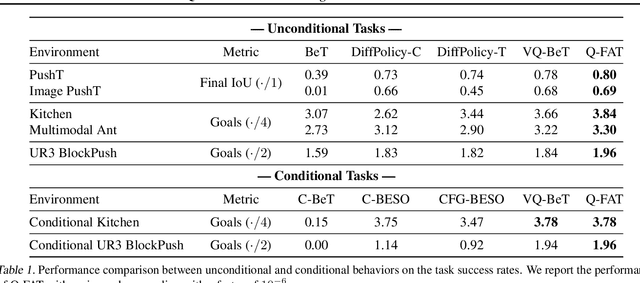

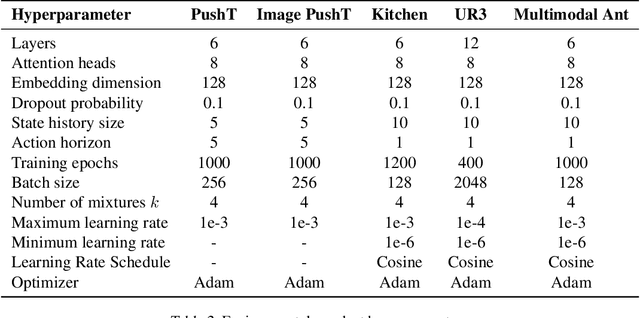
Abstract:Current transformer-based imitation learning approaches introduce discrete action representations and train an autoregressive transformer decoder on the resulting latent code. However, the initial quantization breaks the continuous structure of the action space thereby limiting the capabilities of the generative model. We propose a quantization-free method instead that leverages Generative Infinite-Vocabulary Transformers (GIVT) as a direct, continuous policy parametrization for autoregressive transformers. This simplifies the imitation learning pipeline while achieving state-of-the-art performance on a variety of popular simulated robotics tasks. We enhance our policy roll-outs by carefully studying sampling algorithms, further improving the results.
SigLIP 2: Multilingual Vision-Language Encoders with Improved Semantic Understanding, Localization, and Dense Features
Feb 20, 2025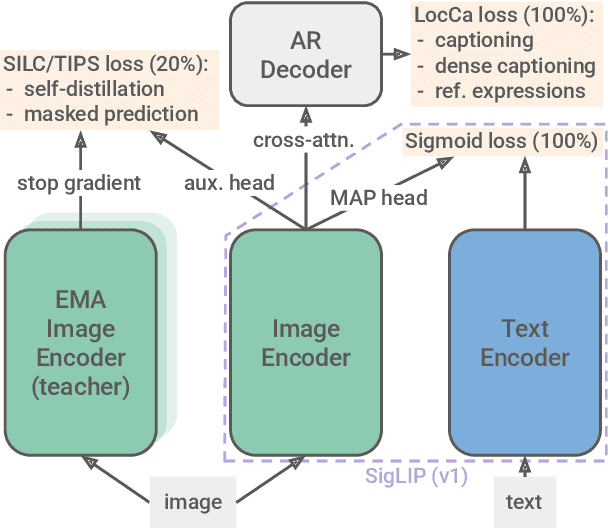
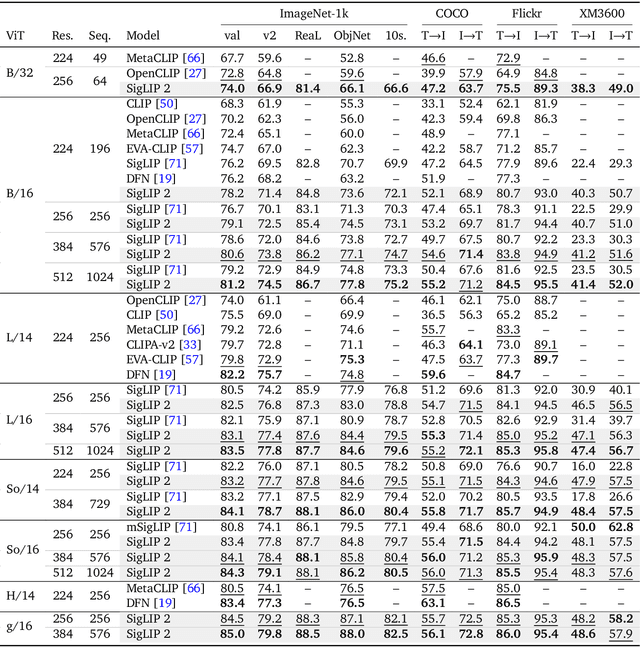
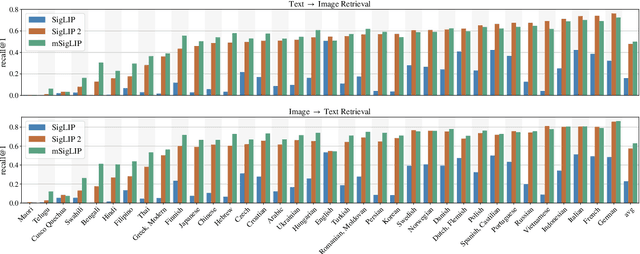

Abstract:We introduce SigLIP 2, a family of new multilingual vision-language encoders that build on the success of the original SigLIP. In this second iteration, we extend the original image-text training objective with several prior, independently developed techniques into a unified recipe -- this includes captioning-based pretraining, self-supervised losses (self-distillation, masked prediction) and online data curation. With these changes, SigLIP 2 models outperform their SigLIP counterparts at all model scales in core capabilities, including zero-shot classification, image-text retrieval, and transfer performance when extracting visual representations for Vision-Language Models (VLMs). Furthermore, the new training recipe leads to significant improvements on localization and dense prediction tasks. We also train variants which support multiple resolutions and preserve the input's native aspect ratio. Finally, we train on a more diverse data-mixture that includes de-biasing techniques, leading to much better multilingual understanding and improved fairness. To allow users to trade off inference cost with performance, we release model checkpoints at four sizes: ViT-B (86M), L (303M), So400m (400M), and g (1B).
Jet: A Modern Transformer-Based Normalizing Flow
Dec 19, 2024



Abstract:In the past, normalizing generative flows have emerged as a promising class of generative models for natural images. This type of model has many modeling advantages: the ability to efficiently compute log-likelihood of the input data, fast generation and simple overall structure. Normalizing flows remained a topic of active research but later fell out of favor, as visual quality of the samples was not competitive with other model classes, such as GANs, VQ-VAE-based approaches or diffusion models. In this paper we revisit the design of the coupling-based normalizing flow models by carefully ablating prior design choices and using computational blocks based on the Vision Transformer architecture, not convolutional neural networks. As a result, we achieve state-of-the-art quantitative and qualitative performance with a much simpler architecture. While the overall visual quality is still behind the current state-of-the-art models, we argue that strong normalizing flow models can help advancing research frontier by serving as building components of more powerful generative models.
PaliGemma 2: A Family of Versatile VLMs for Transfer
Dec 04, 2024



Abstract:PaliGemma 2 is an upgrade of the PaliGemma open Vision-Language Model (VLM) based on the Gemma 2 family of language models. We combine the SigLIP-So400m vision encoder that was also used by PaliGemma with the whole range of Gemma 2 models, from the 2B one all the way up to the 27B model. We train these models at three resolutions (224px, 448px, and 896px) in multiple stages to equip them with broad knowledge for transfer via fine-tuning. The resulting family of base models covering different model sizes and resolutions allows us to investigate factors impacting transfer performance (such as learning rate) and to analyze the interplay between the type of task, model size, and resolution. We further increase the number and breadth of transfer tasks beyond the scope of PaliGemma including different OCR-related tasks such as table structure recognition, molecular structure recognition, music score recognition, as well as long fine-grained captioning and radiography report generation, on which PaliGemma 2 obtains state-of-the-art results.
JetFormer: An Autoregressive Generative Model of Raw Images and Text
Nov 29, 2024



Abstract:Removing modeling constraints and unifying architectures across domains has been a key driver of the recent progress in training large multimodal models. However, most of these models still rely on many separately trained components such as modality-specific encoders and decoders. In this work, we further streamline joint generative modeling of images and text. We propose an autoregressive decoder-only transformer - JetFormer - which is trained to directly maximize the likelihood of raw data, without relying on any separately pretrained components, and can understand and generate both text and images. Specifically, we leverage a normalizing flow model to obtain a soft-token image representation that is jointly trained with an autoregressive multimodal transformer. The normalizing flow model serves as both an image encoder for perception tasks and an image decoder for image generation tasks during inference. JetFormer achieves text-to-image generation quality competitive with recent VQ-VAE- and VAE-based baselines. These baselines rely on pretrained image autoencoders, which are trained with a complex mixture of losses, including perceptual ones. At the same time, JetFormer demonstrates robust image understanding capabilities. To the best of our knowledge, JetFormer is the first model that is capable of generating high-fidelity images and producing strong log-likelihood bounds.
PaliGemma: A versatile 3B VLM for transfer
Jul 10, 2024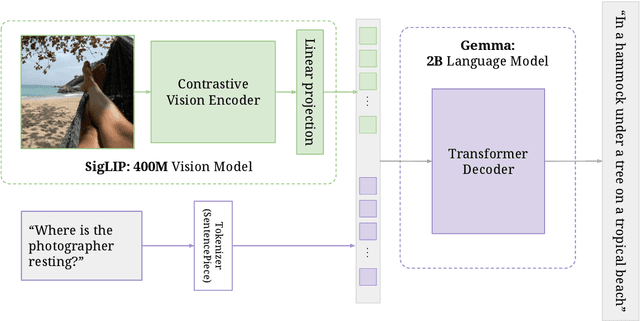
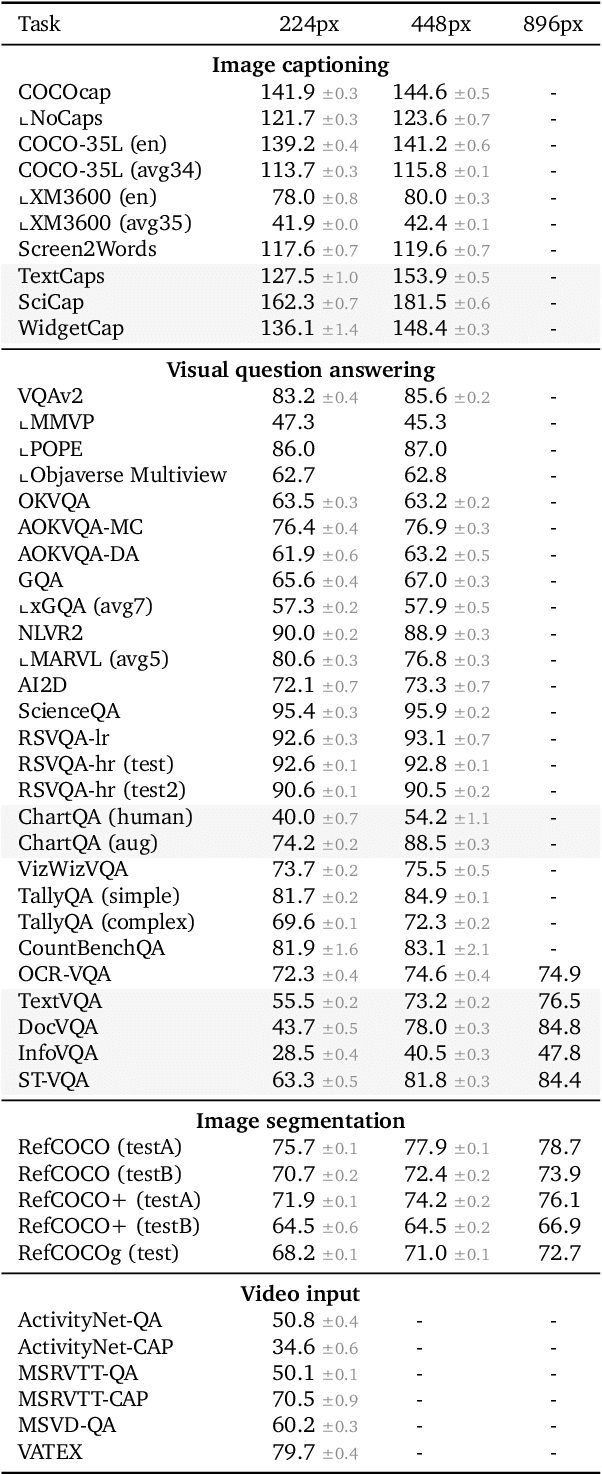
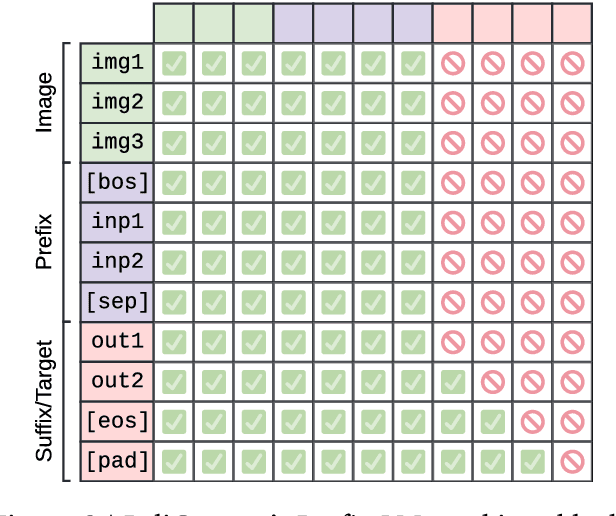
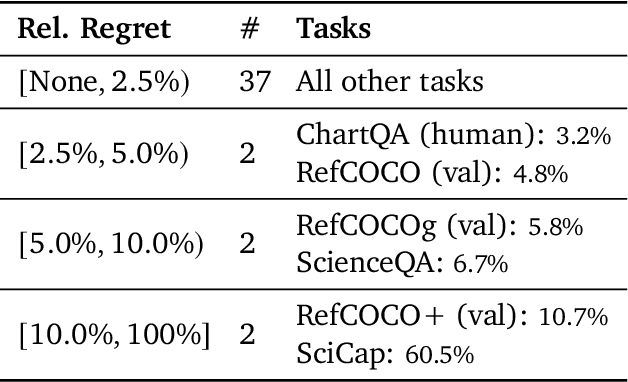
Abstract:PaliGemma is an open Vision-Language Model (VLM) that is based on the SigLIP-So400m vision encoder and the Gemma-2B language model. It is trained to be a versatile and broadly knowledgeable base model that is effective to transfer. It achieves strong performance on a wide variety of open-world tasks. We evaluate PaliGemma on almost 40 diverse tasks including standard VLM benchmarks, but also more specialized tasks such as remote-sensing and segmentation.
LocCa: Visual Pretraining with Location-aware Captioners
Mar 28, 2024



Abstract:Image captioning has been shown as an effective pretraining method similar to contrastive pretraining. However, the incorporation of location-aware information into visual pretraining remains an area with limited research. In this paper, we propose a simple visual pretraining method with location-aware captioners (LocCa). LocCa uses a simple image captioner task interface, to teach a model to read out rich information, i.e. bounding box coordinates, and captions, conditioned on the image pixel input. Thanks to the multitask capabilities of an encoder-decoder architecture, we show that an image captioner can easily handle multiple tasks during pretraining. Our experiments demonstrate that LocCa outperforms standard captioners significantly on localization downstream tasks while maintaining comparable performance on holistic tasks.
Towards Truly Zero-shot Compositional Visual Reasoning with LLMs as Programmers
Jan 03, 2024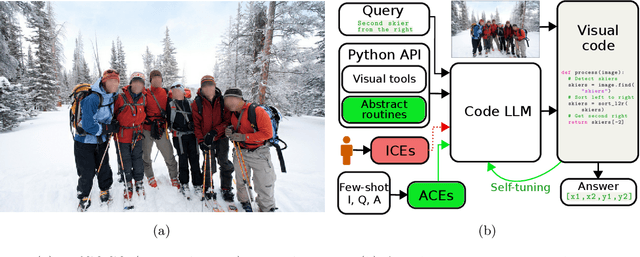
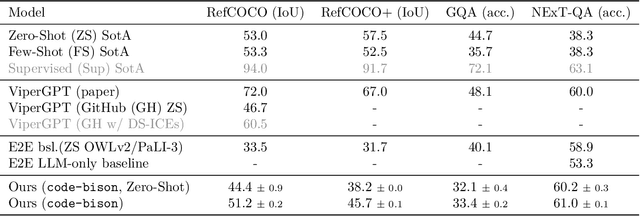


Abstract:Visual reasoning is dominated by end-to-end neural networks scaled to billions of model parameters and training examples. However, even the largest models struggle with compositional reasoning, generalization, fine-grained spatial and temporal reasoning, and counting. Visual reasoning with large language models (LLMs) as controllers can, in principle, address these limitations by decomposing the task and solving subtasks by orchestrating a set of (visual) tools. Recently, these models achieved great performance on tasks such as compositional visual question answering, visual grounding, and video temporal reasoning. Nevertheless, in their current form, these models heavily rely on human engineering of in-context examples in the prompt, which are often dataset- and task-specific and require significant labor by highly skilled programmers. In this work, we present a framework that mitigates these issues by introducing spatially and temporally abstract routines and by leveraging a small number of labeled examples to automatically generate in-context examples, thereby avoiding human-created in-context examples. On a number of visual reasoning tasks, we show that our framework leads to consistent gains in performance, makes LLMs as controllers setup more robust, and removes the need for human engineering of in-context examples.
GIVT: Generative Infinite-Vocabulary Transformers
Dec 04, 2023



Abstract:We introduce generative infinite-vocabulary transformers (GIVT) which generate vector sequences with real-valued entries, instead of discrete tokens from a finite vocabulary. To this end, we propose two surprisingly simple modifications to decoder-only transformers: 1) at the input, we replace the finite-vocabulary lookup table with a linear projection of the input vectors; and 2) at the output, we replace the logits prediction (usually mapped to a categorical distribution) with the parameters of a multivariate Gaussian mixture model. Inspired by the image-generation paradigm of VQ-GAN and MaskGIT, where transformers are used to model the discrete latent sequences of a VQ-VAE, we use GIVT to model the unquantized real-valued latent sequences of a VAE. When applying GIVT to class-conditional image generation with iterative masked modeling, we show competitive results with MaskGIT, while our approach outperforms both VQ-GAN and MaskGIT when using it for causal modeling. Finally, we obtain competitive results outside of image generation when applying our approach to panoptic segmentation and depth estimation with a VAE-based variant of the UViM framework.
Finite Scalar Quantization: VQ-VAE Made Simple
Oct 12, 2023



Abstract:We propose to replace vector quantization (VQ) in the latent representation of VQ-VAEs with a simple scheme termed finite scalar quantization (FSQ), where we project the VAE representation down to a few dimensions (typically less than 10). Each dimension is quantized to a small set of fixed values, leading to an (implicit) codebook given by the product of these sets. By appropriately choosing the number of dimensions and values each dimension can take, we obtain the same codebook size as in VQ. On top of such discrete representations, we can train the same models that have been trained on VQ-VAE representations. For example, autoregressive and masked transformer models for image generation, multimodal generation, and dense prediction computer vision tasks. Concretely, we employ FSQ with MaskGIT for image generation, and with UViM for depth estimation, colorization, and panoptic segmentation. Despite the much simpler design of FSQ, we obtain competitive performance in all these tasks. We emphasize that FSQ does not suffer from codebook collapse and does not need the complex machinery employed in VQ (commitment losses, codebook reseeding, code splitting, entropy penalties, etc.) to learn expressive discrete representations.
 Add to Chrome
Add to Chrome Add to Firefox
Add to Firefox Add to Edge
Add to Edge